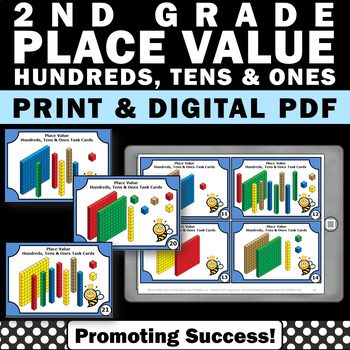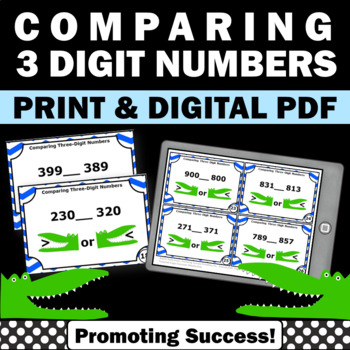Place Value Strategies
Click HERE to PIN to SAVE for later!
According to National Council of Teachers of Mathematics (NCTM), "developing an understanding of place value and the base-ten number system was considered a fundamental goal of the early primary grades."
1. Begin with group-able manipulatives. Some examples are straws, Popsicle sticks, snap cubes, etc. Regrouping is the term that is interchangeable with "carrying" and "borrowing." Regrouping across ones and tens is the first step in understanding operations across the base ten system, and often the key to future success with long division and multiple digit multiplication.
2. Count groups as single objects. Students' first counting experiences involve an understanding on one-to-one correspondence. When dealing with numbers beyond ten, it will be efficient for students to count it by groups as though they were individual objects.
3. Connect to the real world. The best example of place value in real life is with money: dimes and pennies for two-digit numbers. Use one, tens, and hundred-dollar bills for three-digit place value. You can also use situations like pencils in boxes of ten. You have five boxes and seven extra pencils, therefore you have 57 pencils. You can think about a large group of children with ten kids on a team. Or you can think about tables at a banquet hall with ten chairs at each table.
4. Take small steps and scaffold instruction. Begin with two digits, then three, etc. Scaffolding is an instructional technique whereby the teacher models the desired learning strategy or task, then gradually shifts responsibility to the students.
5. Include rounding. You can usually tell when students have a good grasp of place value by their ability to round numbers. When students understand place value, they are quick to be able to round numbers to a specific place.
6. Use chants and music to enhance memory. Students can create their own chants and video them. Otherwise, YouTube has many!
7. Let the student move and be a part of place value. Create a place value chart on the floor. Give students number cards and have them physically move to specific places on the number chart. Brain research shows that movement in the classroom increases student achievement! (Plus, it is FUN!) These play pieces could be arranged into multi-digit numbers:
8. Use games to reinforce and practice skills. Games are a great way to get every student involved. Games create positive competition, collaborative work and increased comprehension. See games in action here.
9. Use a hundreds chart. A hundreds chart, both a large classroom chart and smaller individual charts can be used in a number of ways to help children understand the base ten number system. The chart can be cut into "tens strips" (i.e. 11-20, 31 to 40, etc.) and then students can order them and paste them in the correct order. The chart can be used to teach skip counting by 5's and 10's, also an important part of understanding place value as well.
10. Help from home. A positive home-school connection is vital to student learning. Ask family members to participate by giving them specific tasks. For example, suggest that they work wit the children to make a chart that shows he place values of numbers from 11 to 19, including visual examples and the words clearly printed. Charts can be used in class or kept at home for math support.
MORE PLACE VALUE RESOURCES IN OUR STORE:
Place Value – Ones and Tens Math Task Cards
Place Value – Write Numbers in Standard Form Math Task Cards
Place Value – Write the Larger Number Math Task Cards
Place Value – 6 Digit Place Value Crossword Puzzle
Place Value – 4 Digit Place Value Crossword Puzzle
Place Value – 3 Digit Place Value Crossword Puzzle
Place Value – Find the Missing Value
Place Value – Hundreds, Tens and Ones Math Task Cards
Converting Between Place Value Math Task Cards
Place Value – Write in Standard Form Math Task Cards – Two Task Cards Per Page
Place Value Math Task Cards – Write the Value of the Underlined Digit
Place Value Activity Packet
Comparing Two-Digit Numbers Math Task Cards
Comparing Three-Digit Numbers Math Task Cards
Comparing Multi-Digit Numbers Math Task Cards
Comparing Fractions Math Task Cards
Comparing Decimals to the Thousandths Math Task Cards
Free Converting Between Place Values Math Task Cards
Free Place Value – Hundreds, Tens and Ones Math Task Cards
Free Greater Than/Less Than Anchor Chart Poster
Free Top 20 Uses for Task Cards
-----------------------------------------
You may also like these blog posts:
-----------------------------------------
You may also like these printable math resources from our store:
MORE PLACE VALUE RESOURCES IN OUR STORE:
Place Value – Ones and Tens Math Task Cards
Place Value – Write Numbers in Standard Form Math Task Cards
Place Value – Write the Larger Number Math Task Cards
Place Value – 6 Digit Place Value Crossword Puzzle
Place Value – 4 Digit Place Value Crossword Puzzle
Place Value – 3 Digit Place Value Crossword Puzzle
Place Value – Find the Missing Value
Place Value – Hundreds, Tens and Ones Math Task Cards
Converting Between Place Value Math Task Cards
Place Value – Write in Standard Form Math Task Cards – Two Task Cards Per Page
Place Value Math Task Cards – Write the Value of the Underlined Digit
Place Value Activity Packet
Comparing Two-Digit Numbers Math Task Cards
Comparing Three-Digit Numbers Math Task Cards
Comparing Multi-Digit Numbers Math Task Cards
Comparing Fractions Math Task Cards
Comparing Decimals to the Thousandths Math Task Cards
Free Converting Between Place Values Math Task Cards
Free Place Value – Hundreds, Tens and Ones Math Task Cards
Free Greater Than/Less Than Anchor Chart Poster
Free Top 20 Uses for Task Cards
---------------------------------------
Click HERE to view our Teachers Pay Teachers Promoting Success store.
Click HERE to SUBSCRIBE to our newsletter for SECRET SALES and FREE printables.
Click HERE to follow us on Instagram.















No comments:
Post a Comment